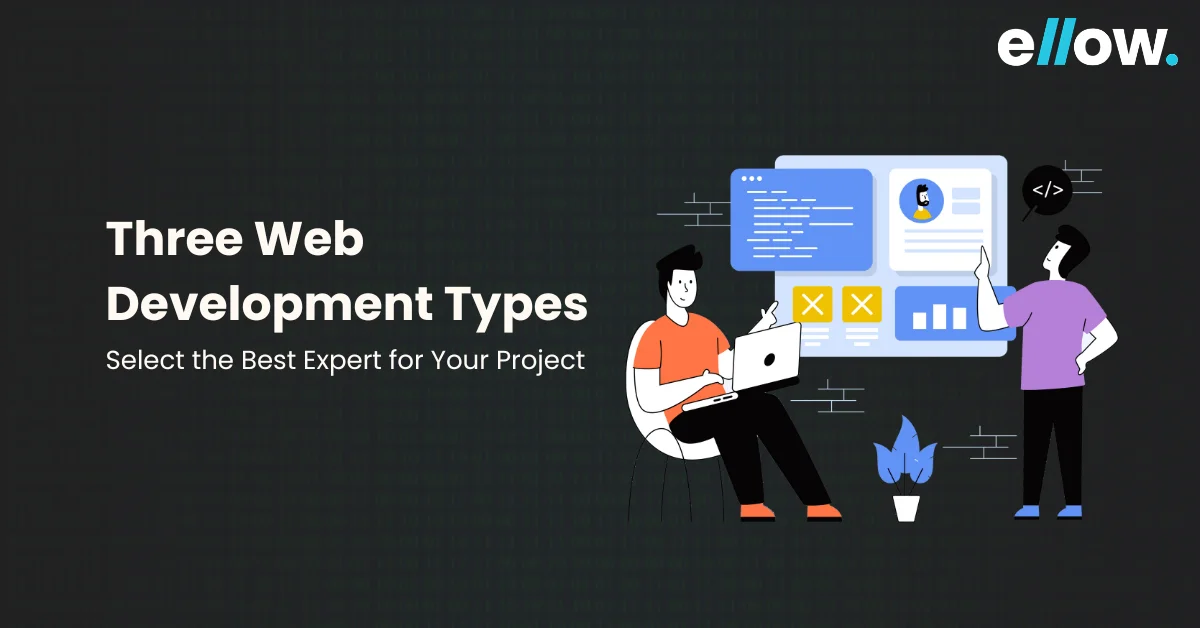Let’s build the future together.
Great ideas need great people. Partner with us to bring your vision to life, or take the first step in your career by joining our team of innovators.

The world is just a click away; in that world, the significance of web development cannot be overstated. According to Statista, the employment of web developers and digital interface designers in the United States is projected to reach over 260,000 by 2028.
There are no second thoughts here regarding the world being at our fingertips, all because of the evolution of web development types and the technologies that support them.
With access to all kinds of information within seconds of searching, more people rely on the internet hence the migration of businesses to cyberspace.
Websites have become crucial for any company’s success because they serve as their initial point of contact with customers. And the “behind the scenes” work that goes into creating these websites is called web development.
How interactive the website is, depends on how strategic its web development is. And this leads to what our article will cover. Today, we will be manifesting details about the three web development types.
Alongside that, we will unravel the tips on knowing what web developer will be best suited for your project. Many e-commerce companies integrate their eCommerce ERP system with their back-end operations to streamline processes, improve inventory management, and ensure real-time synchronization of data between online sales and broader business functions.
Web development involves creating and maintaining websites, encompassing everything from their layout and design to the underlying logic and functionality.
While design is important, web development primarily focuses on functionality, ensuring that every click or interaction on the website performs as intended. It involves writing code in various programming languages to handle user inputs, process data, and generate dynamic content.
Web development can range from creating simple web pages to complex web applications or social media platforms. Developers tailor their approach based on client requirements, adding features and functionality as needed. This scalability ensures that websites can grow and adapt to changing demands over time.
A well-developed website is essential for businesses looking to establish their online presence and connect with customers. It serves as a digital storefront, providing valuable information, facilitating transactions, and enhancing brand visibility. By investing in robust web development, businesses can drive revenue and maximize returns on investment.
Web development can be divided into three distinct categories, each with its own set of languages, frameworks, and tools.
Front-end development focuses on crafting the user-facing aspect of websites and applications, ensuring they are intuitive and visually appealing. It involves planning, designing, and refining the interface that users interact with, aiming to deliver a seamless and engaging experience.
Front-end developers utilize various tools and techniques to create responsive layouts, optimize performance, and enhance usability across different devices.
They work closely with designers to translate visual concepts into functional elements and collaborate with back-end developers to integrate front-end components with server-side logic. Overall, front-end development plays a crucial role in shaping the user experience and driving engagement on digital platforms.
Commonly used languages include HTML, CSS3, and JavaScript.
Popular tools such as Svelte, jQuery, Node.js, Amber.js, React JS, Angular JS, and Backbone.js streamline development by offering pre-written code snippets.
Check this video out: Front End Developer Roadmap 2024
Back-end development forms the backbone of websites, managing server-side operations like database management, logic implementation, and server configuration. It involves intricate planning, designing, and testing to ensure smooth functionality and responsiveness. Back-end developers focus on optimizing website performance and security, handling user authentication, data storage, and retrieval efficiently.
They play a crucial role in ensuring seamless communication between the server and the client-side interface. With expertise in various technologies and tools, back-end developers ensure that websites operate flawlessly, providing users with a seamless experience while interacting with the application’s front end.
Dynamic languages like C#, C++, SQL, PHP, Java, Ruby, Python, Golang, Node.js, and JavaScript are commonly used.
Frameworks like .Net, Flask, Spring, Meteor, Django, Laravel, Apache, and CherryPy support efficient back-end development.
Integral to dynamic websites, databases store and manage website data. Popular options include Oracle, MySQL, IBM DB2, MongoDB, Elasticsearch, and MS SQL Server.
Check this video out: Back End Developer Roadmap 2024
Full-stack development combines both front-end and back-end aspects of web development. A full-stack developer handles everything from designing user interfaces to managing databases and server-side logic. They possess a comprehensive understanding of the entire web development process, allowing them to create seamless and cohesive web applications.
Full-stack developers ensure that websites function smoothly and efficiently by bridging the gap between the client and server sides. Their versatility and expertise make them invaluable assets in developing dynamic and interactive web experiences.
Full-stack developers typically work with CSS3, HTML5, JavaScript, PHP, Elixir, Ruby, Python, and TypeScript.
Frameworks such as D3.js, Django, NodeJS, ASP.Net, EmberJS, Angular.js, BootStrap, and Ruby on Rails facilitate full-stack development.
For data management, full-stack developers utilize databases like Oracle, MS SQL, and MongoDB, along with various other tools like text editors (Atom, Sublime, Visual Studio) to streamline the development process.
Check this video out: Become a Full Stack Developer: A Roadmap for Beginners
Before diving into hiring a web developer, it’s crucial to understand the nuances of web development and how they align with your project’s needs. Here are the factors to consider:
The magnitude of your project sets the tone for the expertise required. For large-scale endeavors involving complex web apps integrated with various systems, seasoned developers with a full range of skills are indispensable. Conversely, medium-sized projects like blogs or static web apps may demand less specialized knowledge, while simple updates might suffice with a junior developer.
Clarifying the roles and responsibilities in web development is essential. While the term “web designer” is often misconstrued, each phase of development necessitates distinct expertise. Familiarity with different software development methodologies such as Agile, DevOps, Waterfall, and Rapid Application Development is vital for seamless project execution.
Understanding where your project stands in its development lifecycle is crucial for hiring the right developer:
Align your project goals with the required expertise, whether it’s front-end, back-end, or full-stack development. Look for developers proficient in essential languages like HTML/CSS, JavaScript, and tools like WordPress and Photoshop. Soft skills like communication and problem-solving are equally crucial for effective collaboration and project success.
Determine the hiring model that best suits your project’s needs and budget:
These are valuable insights into various aspects of web development, including different types, technologies involved, and factors crucial in selecting the right programming language. Additionally, we have explored common queries surrounding web-based software development.
Now, if you’re gearing up to create top-notch web-based or enterprise solutions, consider leveraging the expertise of our full-stack web developers at ellow.io for hiring developers. Our team stands ready to assist you in bringing your web app ideas to life. Reach out to our team today to kickstart your project with confidence.
15 Best Front-End Technologies To Use In 2023
Frontend vs Backend Development in 2024: Backbone of Digital Experiences
Top 10 Backend Technologies You Must Know in 2024
How to become a full stack developer?
5 Best Full Stack Project Ideas in 2024
Full-Stack vs MEAN Stack vs MERN Stack: Which Tech Stack to Choose in 2024?
Web development primarily encompasses three types: front-end development, back-end development, and full-stack development.
Front-end development focuses on creating the visible aspects of a website or web application that users interact with directly, including layouts, designs, and user interfaces.
Back-end development involves the creation and management of the server side of a website or web application. It includes tasks such as database management, server configuration, and handling user authentication.
Full-stack development refers to proficiency in both front-end and back-end development. Full-stack developers are capable of working on all aspects of a web project, from the user interface to the server-side logic.
The choice of web development type depends on the specific requirements of your project. If you need a visually appealing and interactive interface, focus on front-end development. For complex functionalities and server-side operations, prioritize back-end development. If you require expertise in both areas, opt for full-stack development.

How Top SaaS Companies Build Agile Teams with Remote Developers

How to Hire Vetted Remote Developers in a Hyper-Competitive Market

Top 5 Countries to Hire Remote Developers (and Why)
Please feel free to share your thoughts and we can discuss it over a cup of tea.
Get a quote
How Top SaaS Companies Build Agile Teams with Remote Developers

Six Things to Consider When Hiring Remote Talent

ellow.io enters remote hires market with AI-based screening process